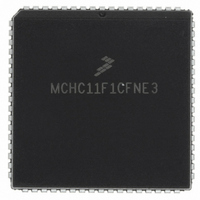MCHC11F1CFNE3 Freescale Semiconductor, MCHC11F1CFNE3 Datasheet - Page 111

MCHC11F1CFNE3
Manufacturer Part Number
MCHC11F1CFNE3
Description
IC MCU 8BIT 1K RAM 68-PLCC
Manufacturer
Freescale Semiconductor
Series
HC11r
Specifications of MCHC11F1CFNE3
Core Processor
HC11
Core Size
8-Bit
Speed
3MHz
Connectivity
SCI, SPI
Peripherals
POR, WDT
Number Of I /o
30
Program Memory Type
ROMless
Eeprom Size
512 x 8
Ram Size
1K x 8
Voltage - Supply (vcc/vdd)
4.75 V ~ 5.25 V
Data Converters
A/D 8x8b
Oscillator Type
Internal
Operating Temperature
-40°C ~ 85°C
Package / Case
68-PLCC
A/d Inputs
8-Channel, 8-Bit
Eeprom Memory
512 Bytes
Input Output
30
Interface
SCI/SPI
Memory Type
EPROM
Number Of Bits
8
Package Type
68-pin PLCC
Programmable Memory
0 Bytes
Timers
3-16-bit
Voltage, Range
3-5.5 V
Controller Family/series
68HC11
No. Of I/o's
30
Eeprom Memory Size
512Byte
Ram Memory Size
1KB
Cpu Speed
3MHz
No. Of Timers
1
Embedded Interface Type
SCI, SPI
Rohs Compliant
Yes
Processor Series
HC11F
Core
HC11
Data Bus Width
8 bit
Program Memory Size
512 B
Data Ram Size
1 KB
Interface Type
SCI, SPI
Maximum Clock Frequency
3 MHz
Number Of Timers
1
Maximum Operating Temperature
+ 85 C
Mounting Style
SMD/SMT
Minimum Operating Temperature
- 40 C
On-chip Adc
8 bit, 8 Channel
Lead Free Status / RoHS Status
Lead free / RoHS Compliant
Program Memory Size
-
Lead Free Status / Rohs Status
RoHS Compliant part
Available stocks
Company
Part Number
Manufacturer
Quantity
Price
Company:
Part Number:
MCHC11F1CFNE3
Manufacturer:
FREESCALE
Quantity:
5 530
Company:
Part Number:
MCHC11F1CFNE3
Manufacturer:
FREESCALE
Quantity:
5 530
Company:
Part Number:
MCHC11F1CFNE3
Manufacturer:
Freescale Semiconductor
Quantity:
10 000
Company:
Part Number:
MCHC11F1CFNE3R
Manufacturer:
Freescale Semiconductor
Quantity:
10 000
9.2 Input Capture
9.2.1 Timer Control Register 2
TCTL2 — Timer Control 2
EDGxB and EDGxA — Input Capture Edge Control
TECHNICAL DATA
RESET:
The input capture function records the time an external event occurs by latching the
value of the free-running counter when a selected edge is detected at the associated
timer input pin. Software can store latched values and use them to compute the peri-
odicity and duration of events. For example, by storing the times of successive edges
of an incoming signal, software can determine the period and pulse width of a signal.
To measure period, two successive edges of the same polarity are captured. To mea-
sure pulse width, two alternate polarity edges are captured.
In most cases, input capture edges are asynchronous to the internal timer counter,
which is clocked relative to an internal clock (PH2). These asynchronous capture re-
quests are synchronized to PH2 so that the latching occurs on the opposite half cycle
of PH2 from when the timer counter is being incremented. This synchronization pro-
cess introduces a delay from when the edge occurs to when the counter value is de-
tected. Because these delays offset each other when the time between two edges is
being measured, the delay can be ignored. When an input capture is being used with
an output compare, there is a similar delay between the actual compare point and
when the output pin changes state.
The control and status bits that implement the input capture functions are contained in
the PACTL, TCTL2, TMSK1, and TFLG1 registers.
To configure port A bit 3 as an input capture, clear the DDA3 bit of the DDRA register.
Note that this bit is cleared out of reset. To enable PA3 as the fourth input capture, set
the I4/O5 bit in the PACTL register. Otherwise, PA3 is configured as a fifth output com-
pare out of reset, with bit I4/O5 being cleared. If the DDA3 bit is set (configuring PA3
as an output), and IC4 is enabled, then writes to PA3 cause edges on the pin to result
in input captures. Writing to TI4/O5 has no effect when the TI4/O5 register is acting as
IC4.
Use the control bits of this register to program input capture functions to detect a par-
ticular edge polarity on the corresponding timer input pin. Each of the input capture
functions can be independently configured to detect rising edges only, falling edges
only, any edge (rising or falling), or to disable the input capture function. The input cap-
ture functions operate independently of each other and can capture the same TCNT
value if the input edges are detected within the same timer count cycle.
There are four pairs of these bits. Each pair is cleared to zero by reset and must be
encoded to configure the corresponding input capture edge detector circuit. IC4 func-
tions only if the I4/O5 bit in the PACTL register is set. Refer to Table 9-2 for timer con-
trol configuration.
EDG4B
Bit 7
0
EDG4A
6
0
Freescale Semiconductor, Inc.
For More Information On This Product,
EDG1B
5
0
Go to: www.freescale.com
TIMING SYSTEM
EDG1A
4
0
EDG2B
0
3
EDG2A
2
0
EDG3B
1
0
EDG3A
Bit 0
0
$1021
9-5











